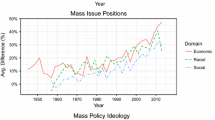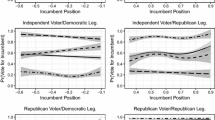Abstract
Are voters in the United States sorting into geographic “enclaves” of determined commitment to one party or the other, or do voting and public opinion patterns hide a fundamentally ambivalent electorate? The most common geographic measure of partisanship—the presidential vote—cannot identify strength of commitment to the parties because voters have no viable alternative to the major-party candidates. We use party registration statistics instead, since voters can safely register with a third party or as an independent without giving up their right to choose a major-party candidate in the fall election. These numbers suggest that the strongest trend by far is not growing polarization but the large and pervasive increase in registered independents. Although the 2008 election was extraordinary in many ways, its impact on these basic trends is ambiguous. We offer some preliminary analysis that suggests this trend is ideologically meaningful and bears important implications for polarization, and then make a case for further research on the independent phenomenon.







Similar content being viewed by others
Notes
Bruce I. Oppenheimer, “Deep Red and Blue Congressional Districts: The Causes and Con-sequences of Declining Party Responsiveness.” in Congress Reconsidered, ed. Lawrence C. Dodd and Bruce I. Oppenheimer (Washington, DC: CQ Press, 2005); Jeffrey M Stonecash, Mark D. Brewer, and Mack D. Mariani, Diverging Parties: Social Change, Realignment, and Party Polarization (Boulder, CO: Westview Press, 2003).
Bill Bishop, The Big Sort: Why the Clustering of Like-Minded America Is Tearing Us Apart (New York: Houghton Mifflin, 2008).
Stephen Ansolabehere, Jonathan Rodden, and James M. Snyder Jr., “Purple America.” Journal of Economic Perspectives 20.2 (2006): 97-118; Edward L. Glaeser and Bryce A. Ward, “Myths and Realities of American Political Geography”, Journal of Economic Perspectives 20.2 (2006): 119-44; Philip A. Klinkner, “Red and Blue Scare: The Continuing Diversity of the American Electoral Landscape,” The Forum 2.2 (2004): Article 2; Philip A. Klinkner and Ann Hapanowicz, “Red and Blue Deja Vu: Measuring Political Polarization in the 2004 Election,” The Forum 3.2 (2005): Article 2.
Morris P. Fiorina, Jeremy C. Pope, and Samuel J. Abrams, Culture War? The Myth of a Polarized America (New York: Pearson Longman, 2006).
Fiorina, Pope, and Abrams, Culture War?
Paul DiMaggio, John Evans, and Bethany Bryson, “Have American's Social Attitudes Become More Polarized?” The American Journal of Sociology 102.3 (1996): 690–755.
Lisa M. Nunn and John H. Evans, “Geographic Polarization in Social Attitudes,” San Diego: University of California, 2005.
Ansolabehere, Rodden, and Snyder, “Purple America.”
Alan I. Abramowitz and Kyle Saunders, “Why Can’t We All Just Get Along? The Reality of a Polarized America.” The Forum 3.2 (2005): Article 1 and “Is Polarization a Myth?” The Journal of Politics 70.2 (2008): 542–55.
Glaeser and Ward, “Myths and Realities of American Political Geography”; Nunn and Evans, “Geographic Polarization in Social Attitudes.”
Ansolabehere, Rodden, and Snyder, “Purple America.”
Andrew Gelman, Boris Shor, Joseph Bafumi, and David Park, Red State, Blue State, Rich State, Poor State: Why Americans Vote the Way They Do (Princeton: Princeton University Press, 2008).
Thomas Frank, What's the Matter with Kansas?: How Conservatives Won the Heart of America (New York: Metropolitan Books, 2004).
Morris P. Fiorina and Samuel J. Abrams, “Political Polarization in the American Public,” Annual Review of Political Science 11 (2008): 563–88; Fiorina, Pope, and Abrams, Culture War?
Bruce E. Keith, David B. Magleby, Candice J. Nelson, Elizabeth Orr, Mark C. Westlye, and Raymond E. Wolfinger, The Myth of the Independent Voter (Berkeley: University of California Press, 1992).
Elizabeth R. Gerber and Rebecca B. Morton, “Primary Election Systems and Representation,” The Journal Law, Economics, and Organization 14.2 (1998): 304–24; Kristin Kanthak and Rebecca Morton, “The Effects of Electoral Rules on Congressional Primaries,” in Congressional Primaries and the Politics of Representation, ed. Peter F. Galderisi, Marni Ezra and Michael Lyons (Lanham, MD: Rowman and Littlefield, 2001).
Alaska tracks party registration data by “election districts,” but these districts change over time and so cannot be part of a time-series cross-sectional data set.
A list of states and their disposition for this study is available from the authors on request. Party registration data for the years from 1968 through 1988 come from Inter-University Consortium for Political and Social Research (ICPSR) data set number 9405 (ICPSR 1991). Elections data for the years from 1968 through 1990 come from ICPSR data set number 0013 (ICPSR 1995). See CPSR, Voter Registration in the United States, 1968--1988 (Computer file), Ann Arbor: Inter-university Consortium for Political and Social Research and General Election Data for the United States, 1950--1990. (Computer file), Ann Arbor: Inter-university Consortium for Political and Social Research. The ICPSR does not bear any responsibility for the use to which we put these data or the conclusions of this study. The remainder of the data was collected by the authors from the respective secretaries of state.
Gary King, James Honaker, Anne Joseph, and Kenneth Scheve, “Analyzing Incomplete Political Science Data: An Alternative Algorithm for Multiple Imputation,” The American Political Science Review 95.1 (2001): 49–69.
We ran the presidential vote model in Table 1, using all counties and then just those 21 states available for our party registration analysis. The interaction term between the county's 2004 presidential vote and the election year, which measures the growth of polarization over time, was 0.037 for all counties and 0.035 for our party registration counties. See Table A1 in “Appendix.”
Barry C. Burden and Marni Ezra, “Calculating Voter Turnout in U.S. House Primary Elections,” Electoral Studies 18 (1999): 89–99; Frances Fox Piven and Richard A. Cloward, “Government Statistics and Conflicting Explanations of Nonvoting,” PS: Political Science and Politics 22.3 (1989): 580-88.
Bishop, The Big Sort.
To ensure that our results are not some sort of reverse regression to the mean, we performed the same analysis using the 1968 election as the standard and found almost no discernable trend. These results are in the final column of Table A1 of the appendix.
Larry Bartels, “What's the Matter with ‘What's the Matter with Kansas?’” Quarterly Journal of Political Science 1.2 (2006): 201–26, at 211.
We mean-deviated the 2004 presidential vote so that the year counter reflects the change over time for a county voting at the national average in that election.
It is possible that the growth of independent registration was a clerical phenomenon that reflected a changed way of classifying voters in some party registration states. To address this possibility, we regressed the independent share of registration on time separately for each state. Apart from four outliers (in Colorado, Delaware, Iowa, and Wyoming independent registrants were either more common in the first place or the trend over time has been either weak or negative), the trends were all positive, significant, and comfortably within range of each other. These results are available from the authors by request.
National Election Study data come from ICPSR data set number 08475 and data set number 04245. See Virginia Sapiro, Steven J. Rosenstone, and the National Election Studies, American National Election Studies Cumulative Data File, 1948–2002 (Ann Arbor: Inter-University Consortium for Political and Social Research, computer file, 2004) and University of Michigan, Center for Political Studies, American National Election Study, American National Election Study, 2004: Pre- and Post-Election Survey (Ann Arbor: Inter-University Consortium for Political and Social Research computer file, 2004). Neither ICPSR nor the American National Election Studies bears any responsibility for the use to which we put these data or the conclusions of this study.
Larry M. Bartels, “Partisanship and Voting Behavior,” 1952–1996, American Journal of Political Science 44.1 (2000): 35–50 at 36.
Bartels, “Partisanship and Voting Behavior, 1952–1996.” examines the same NES data through 1996 and concludes that “the distribution of partisan attachments among those citizens who actually got to the polls was not much different in the 1990s from what it had been in the 1950s” (38, emphasis in original). We suspect the different interpretation mostly stems from our longer time series, which puts a slight and temporary uptick in partisanship in 1996 into broader perspective. At any rate, it seems clear that something has changed, since party identifiers were 75 percent of the electorate in 1956 and 66 percent in 2004.
Keith, et al., The Myth of the Independent Voter.
We conducted the same analysis with the Public Policy Institute of California's Statewide Survey of Californians from October 2004 (http://www.ppic.org/main/dataSet.asp?i=543), which asks for party registration and not party identification, but still uses a follow-up question for leaning tendencies. The results are the same.
Fiorina, Pope, and Abrams, Culture War?
Gerber and Morton, “Primary Election Systems and Representation”; Kathnak and Morton, “The Effects of Electoral Rules on Congressional Primaries.”
Bartels, “Partisanship and Voting Behavior, 1952–1996”; Marc J. Hetherington, “Resurgent Mass Partisanship: The Role of Elite Polarization,” The American Political Science Review 95.3 (2001): 619-31.
Alex Spillius, “Swing States Now in Reach as New Voters Flock to Obama's Cause,” The Daily Telegraph, October 13, 2008; Alec MacGillis and Alice Crites, “Registration Gains Favor Democrats: Voter Rolls Swelling in Key States,” The Washington Post, October 6, 2008; Nicholas Confessore and Griff Palmer, “Democrats Are Gaining in State, Registration Data Shows,” The New York Times, October 11, 2008; Nancy Vogel, “Dems Expected to Gain Seats in Capitol,” The Los Angeles Times, October 22, 2008; Anthony R. Wood, “Pennsylvania Democrats Now Outnumber GOP by Almost 1.2 Million,” The Philadelphia Inquirer, October 17, 2008.
The presidential election results by county come from the New York Times website: http://elections.nytimes.com/2008/results/president/map.html. The numbers are technically preliminary and have not been certified by the various secretaries of state, but final certified numbers rarely differ much from preliminary returns.
For the sake of consistency, the model for the presidential vote is calculated only for the states that are also part of the party registration calculations. However, if all states are used the substantive results are unchanged.
As with the rest of the analysis, this statistic is the same regardless whether the presidential vote calculation is limited to party registration states or not.
These statistics were graciously provided by Tom Intorcio of the National Conference of State Legislatures.
Keith, et al., The Myth of the Independent Voter.
Author information
Authors and Affiliations
Rights and permissions
About this article
Cite this article
McGhee, E., Krimm, D. Party Registration and the Geography of Party Polarization. Polity 41, 345–367 (2009). https://doi.org/10.1057/pol.2009.6
Published:
Issue Date:
DOI: https://doi.org/10.1057/pol.2009.6




